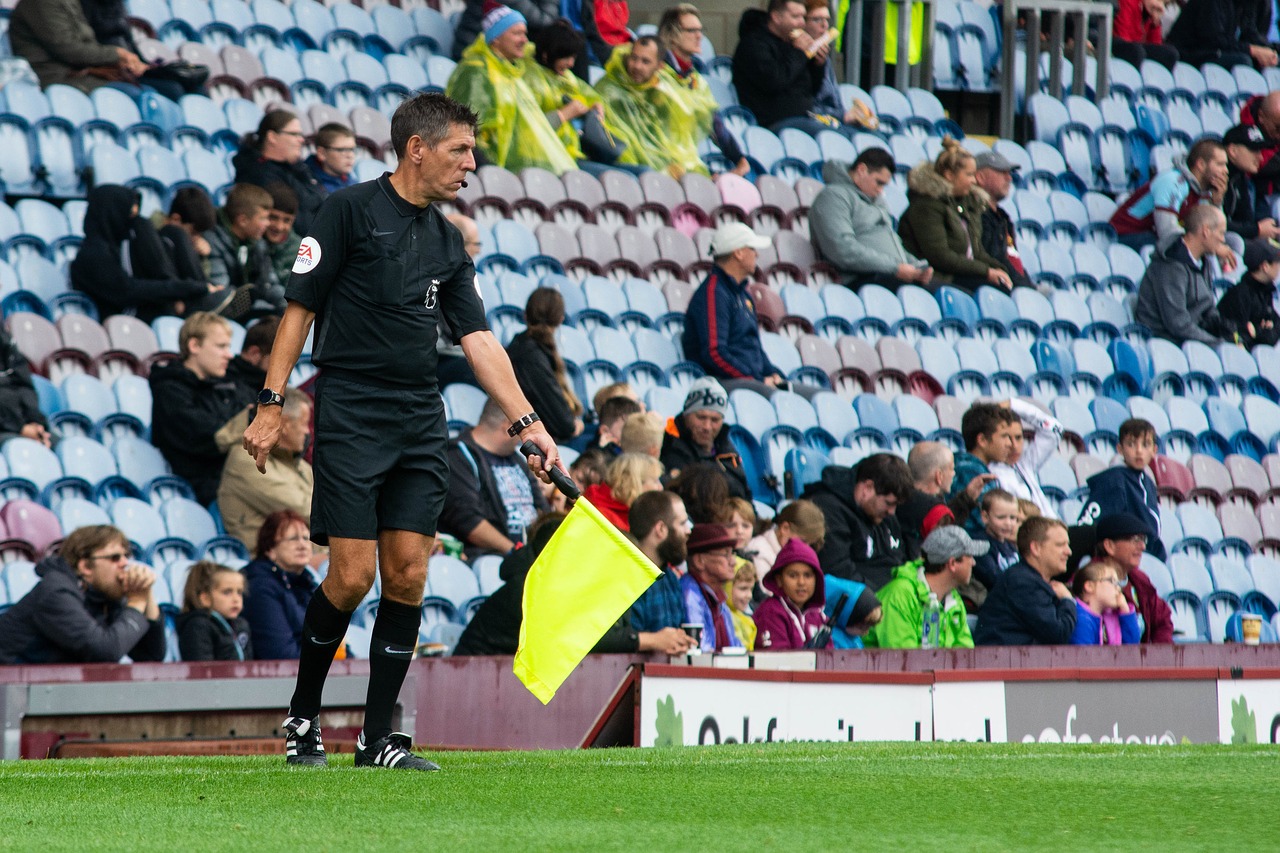Understanding the Offside Rule: A Beginner's Guide

While the basics of football are simple to grasp, some rules can be more challenging to understand. One such rule that often confuses both new and seasoned fans is the offside rule. In this post, we’ll demystify the offside rule, explaining its nuances, importance, and impact on the beautiful game and the strategic approaches coaches and players use to master it.
What is the Offside Rule?
The offside rule, officially known as Law 11 in football’s rulebook, is crucial for preventing attacking players from gaining an unfair advantage. It maintains the balance of the game and encourages strategic play.
A player is in an offside position if:
- They are closer to the opponent’s goal line than the ball and the second-last opponent.
- They are in the opponent’s half of the field.
- They are involved in active play.
Any part of the attacking player’s body (except arms and hands) that is beyond the imaginary line drawn across the field at the position of the second-last defender is considered in an offside position.
However, being in an offside position alone is not an offence. The referee will only call an offside infraction if the player participates in active play.
When Does Offside Occur?
Understanding when offside occurs is crucial for players, coaches, and fans. Here are the key scenarios:
- Receiving the Ball: If a player in an offside position receives the ball from a teammate, they are offside.
- Interfering with Play: Even without touching the ball, a player in an offside position who interferes with an opponent’s ability to play the ball can be called offside.
- Gaining an Advantage: If a player in an offside position plays a ball that rebounds off the goalpost, crossbar, or an opponent, they can be penalized for offside.
Exceptions to the Offside Rule
Not all situations in football are subject to the offside rule. Important exceptions include:
- Goal Kicks: A player cannot be offside from a goal kick.
- Corner Kicks: Offside does not apply when receiving the ball directly from a corner kick.
- Throw-ins: Players are not offside when receiving the ball from a throw-in.
- Own Half: A player cannot be offside in their own half of the field.
Common Misconceptions About the Offside Rule
Despite its importance, the offside rule is often misunderstood. Here are some common misconceptions:
- Myth: A player is always offside if they’re ahead of all defenders.
Reality: The player must also be ahead of the ball and in the opponent’s half. - Myth: You can’t be offside if you don’t touch the ball.
Reality: Interfering with play or an opponent can result in an offside call, even without touching the ball. - Myth: A player is offside if they’re level with the last defender.
Reality: A player must be nearer to the goal line than the second-last opponent to be in an offside position.
Strategic Implications of the Offside Rule
The offside rule significantly impacts how football is played, influencing defensive and attacking strategies. Coaches use various tactics to exploit or counteract the offside rule, adding layers of strategy to the game.
Defensive Strategies
The Offside Trap
Description: The offside trap is a defensive strategy where the backline moves upfield in unison just before the ball is played, leaving the opposing attackers in an offside position. This tactic requires precise timing and communication among defenders.
Execution: Defenders are trained to anticipate when the opposition will make a forward pass. At the right moment, they step up together, catching the attacker offside.
Risks: If mistimed, the offside trap can be risky, exposing the goalkeeper to a one-on-one situation. It demands constant vigilance, as any lapse in coordination can result in a clear scoring chance for the opponent.
High Defensive Line
Description: A high defensive line involves positioning the defence further up the field, closer to the midfield line. This strategy compresses the playing area, making it difficult for the opposition to execute through balls or long passes.
Execution: By pushing up, defenders reduce the space attackers must operate in, often forcing them into offside positions.
Risks: This strategy is vulnerable to fast counter-attacks. If an attacker times their run well, or if the defenders are caught out of position, the opposition can exploit the space behind the defence.
Learn more about the high line in our post: What is a high line in football?
Communication and Zonal Marking
Description: In zonal marking, defenders cover specific areas of the pitch rather than individual players. Effective communication ensures that players know their zones and opposing attackers’ positions.
Execution: Coaches emphasize the importance of verbal and non-verbal communication to ensure that defensive strategies, like the offside trap, are executed correctly.
Risks: Zonal marking can lead to confusion if not well-practised, especially when the opposition uses overlapping runs or quickly switches play.
Attacking Strategies
Timed Runs
Description: Timed runs are essential for attackers to stay onside while breaking through the defensive line. Strikers and wingers must time their movements perfectly in relation to the pass.
Execution: Attackers must watch the last defender and initiate their run just as the ball is played, ensuring they remain onside. Coaches drill attackers in the timing of their runs to avoid frequent offside calls.
Risks: Poorly timed runs can lead to frequent offside calls, disrupting the attacking momentum and wasting potential goal-scoring opportunities.
Third-Man Runs:
Description: The third-man run is a tactic where a player not directly involved in the initial play makes a run into space to receive a pass, often catching the defence off guard.
Execution: The third player stays onside while the first attacker distracts the defence. At the opportune moment, the third man sprints into an attacking position to receive the ball behind the defensive line.
Risks: This tactic requires perfect timing. If the run is too early or too late, the attacker might be flagged offside or miss the opportunity.
Decoy Runs
Description: Decoy runs involve an attacker drawing defenders out of position, creating space for a teammate to exploit. This tactic can confuse defenders and disrupt their organization.
Execution: Coaches train attackers to make runs that pull defenders away from critical areas, allowing another attacker to stay onside and receive the ball in a less contested area.
Risks: Decoy runs can leave the attacking team without sufficient support if not executed properly, leading to missed opportunities.
Quick Combination Play
Description: Quick, short passes, often called “one-twos” or “give-and-go,” are used to break through tight defences. This strategy relies on fast ball movement and precise timing.
Execution: Attackers pass the ball rapidly among themselves, drawing defenders out of position. The final pass is typically made just as the attacker makes a run, keeping them onside.
Risks: This strategy requires high levels of technical skill and coordination. A poorly placed pass or mistimed run can disrupt the flow of the attack and lead to an offside call.
The Evolution of the Offside Rule
The offside rule has undergone significant changes since football’s early days, evolving to enhance the fairness and excitement of the game. Here’s a detailed look at how the rule has developed:
Pre-1863: The Origins of Offside
In the earliest forms of football, the offside rule was more restrictive. Any attacking player positioned ahead of the ball when it was played forward was considered offside. This meant that players had to stay behind the ball to be involved in the play, which severely limited attacking strategies.
1863: The Original Offside Rule
When the first official football rules were codified by the newly formed Football Association (FA) in 1863, the offside rule was included. This original version required that all attacking players be behind the ball when it was played forward. This strict interpretation made it difficult for teams to advance the ball upfield and was later seen as too limiting for the game’s flow.
1925: The Two-Defender Rule
In 1925, a significant change was introduced to make the game more attacking-friendly. The rule was altered so that an attacker would be considered onside if there were at least two defenders (including the goalkeeper) between them and the goal line when the ball was played. This adjustment significantly increased goals scored and changed the game’s dynamics, encouraging more open and attacking play.
1990: The Level-Onside Amendment
The rule was further modified in 1990 to favour attacking players. The amendment stated that a player would be onside if they were level with the second-last defender at the moment the ball was played. This change was made to reduce the number of offside calls and encourage more offensive play, increasing goal-scoring opportunities.
2005: Clarifications on “Interfering with Play” and “Gaining an Advantage”
In 2005, FIFA issued further clarifications to the offside rule, particularly regarding what constituted “interfering with play” and “gaining an advantage” from being in an offside position. These clarifications aimed to make the rule more understandable and to ensure consistent application across different matches and competitions.
2013: The Modern Interpretations
Further refinements were made in 2013 to clarify the situations in which a player could be penalized for being in an offside position. The updated interpretations emphasized that players could only be penalized if they were directly involved in active play, such as touching the ball, obstructing an opponent’s view, or challenging an opponent for the ball. These refinements were introduced to minimize controversial decisions and to keep the game flowing smoothly.
2020s: The Role of VAR in Offside Decisions
The introduction of Video Assistant Referees (VAR) in the late 2010s and early 2020s has profoundly impacted offside decisions. VAR technology allows precise measurements to determine if a player is offside, often down to millimetres. While this has increased accuracy, it has also led to debates about the spirit of the rule and whether such marginal decisions align with the intended purpose of offside.
Recent Discussions: Automated Offside Technology
In response to ongoing debates about the precision of VAR offside calls, FIFA and other football authorities have been exploring automated offside technology. This technology aims to provide even more accurate and quicker decisions, potentially reducing the delays and controversies associated with current VAR implementations.
These changes reflect the ongoing efforts to balance fairness with the excitement of the game. As football continues to evolve, the offside rule will likely remain a central topic of discussion and adaptation.
5 Offside decisions that had a significant impact on FIFA World Cup matches
Ferenc Puskás’s Goal – 1954 FIFA World Cup Final
Match: Hungary vs. West Germany (Final)
Incident: In the 86th minute, with West Germany leading 3-2, Ferenc Puskás scored what appeared to be the equalizing goal for Hungary. However, the goal was controversially ruled offside by the referee, despite debates over whether Puskás was truly offside when he received the ball.
Impact: The decision denied Hungary a potential comeback and allowed West Germany to hold on to their lead, ultimately winning the match and the World Cup. The disallowed goal is still a topic of debate among football historians and fans, with some believing it cost Hungary their deserved victory in what is known as the “Miracle of Bern.”
Roberto Baggio’s Disallowed Goal – 1990 FIFA World Cup
Match: Italy vs. England (Third Place Playoff)
Incident: In the 71st minute, Italian forward Roberto Baggio scored what seemed to be a crucial goal for Italy. However, the goal was disallowed for offside. Replays and analysis show that Baggio was clearly in an onside position when he received the ball, with several meters between him and the nearest defender. The decision was widely criticized as incorrect, and it has been cited as one of the most controversial offside calls in World Cup history.
Impact: The disallowed goal denied Italy a potential lead, and England went on to win the match 2-1. The incident remains a significant example of how offside decisions can drastically impact a World Cup match and has contributed to ongoing discussions about officiating accuracy.
Carlos Tevez’s Goal – 2010 FIFA World Cup
Match: Argentina vs. Mexico (Round of 16)
Incident: Carlos Tevez scored the opening goal for Argentina in a 3-1 victory over Mexico, but the goal was highly controversial because Tevez was clearly offside when Lionel Messi passed the ball to him. Despite protests from the Mexican players and the evidence shown on the stadium’s big screen, the goal was allowed to stand.
Impact: The decision demoralized the Mexican team, and Argentina capitalized on their advantage to secure the win. This incident intensified calls for video technology in football, contributing to the eventual introduction of VAR.
Controversial Offside Leading to Luis Suárez’s Handball – 2010 FIFA World Cup
Match: Uruguay vs. Ghana (Quarterfinal)
Incident: In the final moments of extra time, Ghana’s attack reached a dramatic climax. A cross was delivered into the penalty area, and the Uruguayan goalkeeper, Fernando Muslera, punched the ball away. Ghanaian forward Dominic Adiyiah, wearing number 10, was in an offside position when he attempted a follow-up shot at goal. His shot was blocked by Uruguayan defender Sebastián Coates. The ball then rebounded to another Ghanaian player, Kevin-Prince Boateng, who headed it towards the goal. Luis Suárez, in a dramatic moment, used his hand to stop Boateng’s header from crossing the goal line. Suárez was shown a red card for his actions, and Ghana was awarded a penalty kick.
Impact: Asamoah Gyan missed the crucial penalty, and Uruguay won the ensuing penalty shootout 4-2, advancing to the semifinals. The offside position of Adiyiah and the subsequent handball by Suárez remain contentious points, influencing the debate over officiating decisions in high-stakes matches.
Antonio Rüdiger’s Disallowed Goal – 2022 FIFA World Cup
Match: Germany vs. Spain (Group Stage)
Incident: In the 39th minute, Antonio Rüdiger headed the ball into the net from a free-kick, giving Germany what appeared to be the lead. However, the goal was disallowed after a VAR review determined that Rüdiger was marginally offside when the free-kick was taken. The decision was controversial, as the offside call was incredibly tight.
Impact: The disallowed goal kept the score at 0-0 going into halftime, significantly affecting Germany’s momentum. The match eventually ended in a 1-1 draw, a result that complicated Germany’s path to the knockout stage. The incident added to the ongoing debate over the precision and impact of VAR in offside decisions.
Conclusion
The offside rule, while complex, is an integral part of what makes football the beautiful game we know and love. It adds depth, strategy, and excitement to every match. Whether you’re a player, coach, referee, or fan, a solid understanding of the offside rule enhances your appreciation of the sport.
As you continue to watch and enjoy football, pay close attention to how teams navigate the offside rule. You’ll soon find yourself spotting offside positions and understanding referee decisions more clearly. Like many aspects of football, mastering the offside rule takes time and observation. Keep watching, learning, and, most importantly, enjoying the world’s most popular sport!



